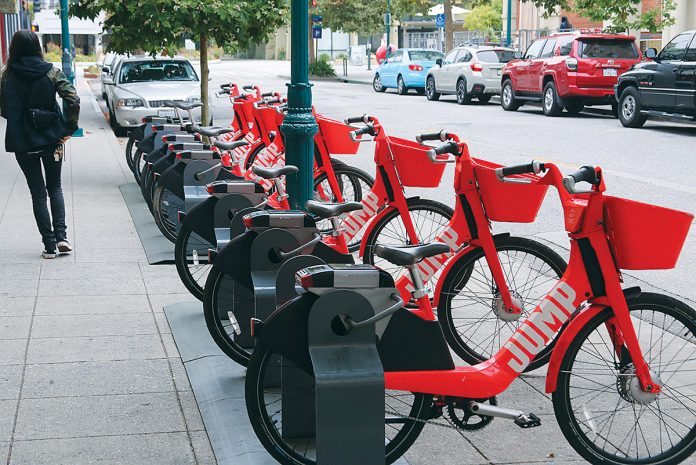SANTA CRUZ COUNTY—Anyone who lived in or visited Santa Cruz in 2018-2019 most likely noticed the red electric bicycles being ridden and parked across the city. Santa Cruz had partnered with Jump Bikes, a company providing affordable short-term bike rentals for trips within city limits.
Jump Bikes pulled out of the area after the pandemic. But local jurisdictions are once again looking to bring back a bike-share program—this time as a countywide initiative.
A coalition from the county’s four cities, UC Santa Cruz and Cabrillo College have been working to find a program that would, in theory, allow people to ride from North Santa Cruz County to Watsonville.
Claire Gallogly, a transportation planner with the city of Santa Cruz, said at a June 22 Santa Cruz City Council meeting that this countywide expansion is overdue. When a Jump rider had tried to travel beyond city limits, the bike would shut down.
“We heard over and over that folks who were using the bikes didn’t necessarily stop their trip at city limits,” Gallogly said. “Setting up a countywide system would allow those trips to take place.”
Proponents say that having more transportation options will also help the environment. Senior Civil Engineer for the city of Watsonville Alex Yasbeck said that such a program could help the city’s Climate Action Plan, which aims to address issues of climate change by 2030.
Not all residents were happy with Jump over its two years in Santa Cruz. Abandoned bikes were being left on sidewalks, in bike lanes, streets and in front of people’s homes
One woman, who said she was blind, called into the June 22 meeting and said that bikes were sometimes left in the way of ADA areas, and that there was no easy way for people to report these issues.
Santa Cruz Vice Mayor Sonja Brunner recalled that one of the biggest customer concerns with Jump was their lack of customer service.
“[Jump] had a local operating team, but the number to call was unresponsive,” Brunner said. “I think that was a missing component that did damage to a lot of public perception of the program.”
Gallogly said that these issues are being addressed in the new Request for Proposal (RFP). A major focus, she said, will be on providing better parking solutions. They also plan to request that the selected vendor hire a local team who can respond to issues faster. Stricter fees for violations and incentives for using bikes properly were also discussed.
Yasbeck points out that in Watsonville, certain laws should be changed to better serve the community through a bike-share program. This includes allowing bikes to ride on sidewalks if necessary, helping seniors and slower riders stay out of dangerous traffic.
Lowering the age of riders from 18 and over to 16 should be addressed as well, he says.
“It’s my personal feeling that if we allow 16-year-olds to have driver’s licenses, why can’t they ride an e-bike?” he said.
Yasbeck presented the program to the Watsonville City Council at its meeting on June 22, on the recommendation of Public Works & Utilities Director Steve Palmisano. The response was mostly positive, but some had concerns.
Watsonville does not have that many safe bike lanes. Councilman Francisco Estrada cited this fact as a reason to be wary of bringing bike share to the city, which has continuously ranked as one of the most dangerous municipalities of its size for pedestrians and cyclists.
“There will need to be a lot more work done, infrastructure-wise, education-wise, before the bikes can be rolled out here,” he said. “I love the idea, I just don’t want any more accidents in Watsonville.”
Some expressed concern over the bikes ending up in the sloughs or being stolen. Others wondered if Watsonville should look into doing its own program, so it can offer different types of bikes or scooters.
Yasbeck says that the outpouring of concern was surprising, but he understood that bike share is new for Watsonville.
“We are a different demographic,” he said. “We don’t have the same number of tourists or attractions [as Santa Cruz]. But if we implement it, stats will show what happens. From there we can see if there are better, more long-term solutions.”
When asked about Estrada’s concern, Yasbeck said that oftentimes, a stronger infrastructure follows increased usage.
“As more people ride bikes, support increases,” he said. “If you only build more bike lanes, people will be like, ‘Why’d you take my parking away?’ If we actually increase ridership, that can help shift perceptions.”
The city councils have unanimously approved the RFP for the program, and are now in the midst of commenting. The coalition aims to release the RFP in August, then begin the selection process. After a vendor is selected, each jurisdiction will negotiate its own contract.
At both the Santa Cruz and Watsonville meetings, council members asked whether the program, which would be of no cost to the jurisdictions, would bring in revenue. Gallogly said they are looking into it, but they didn’t want that to outweigh the public and environmental benefit of bike share.
“I don’t want more fees to be passed on to the users,” she said. “We want to keep prices low enough to get people to think, ‘Bike share can be my first choice.’”









